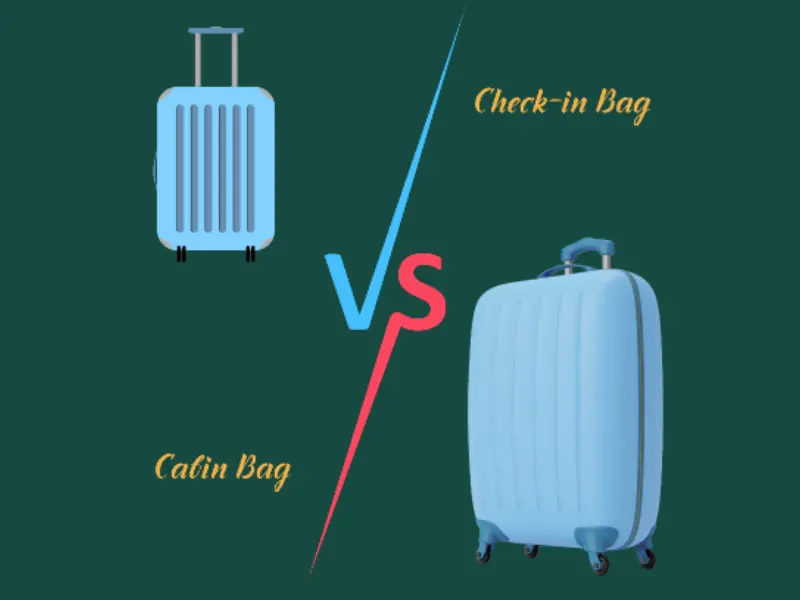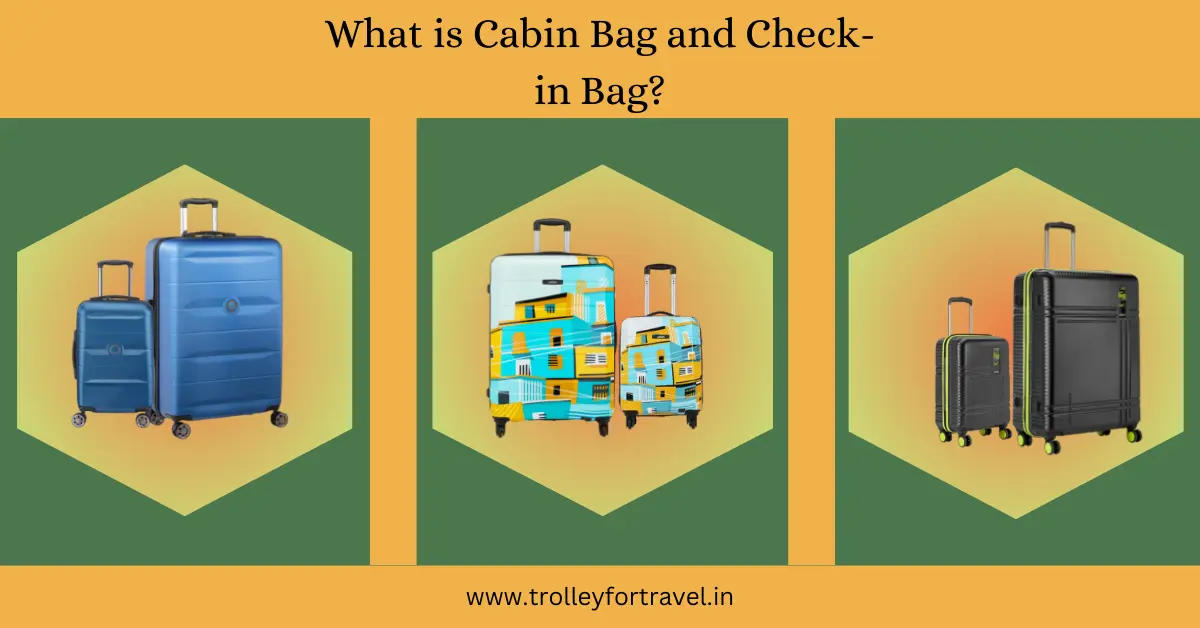Traveling and exploring new places is fun; most of us love it. Whether it’s a quick weekend getaway or an extended international adventure, packing efficiently and choosing the right type of luggage is crucial. Two commonly used options are the check in bag and cabin bag, each serving specific purposes and catering to different travel needs. In this article, we will come to know what is cabin bag and check in bag. We will also talk about the difference between these two baggage types. This will help you make informed decisions.
Recommended for You:
- 10 Best Small Trolley Suitcases for Short Trips
- 10 Best Trolley Bag Sets of 3 for Family Vacation
- Polypropylene vs Polycarbonate – Which Material is Best for Trolley Bags
- Size Matters: Measuring Your Trolley Bag in Inches and Centimeters

What is Cabin Bag and Check in Bag?
Cabin Bag: Compact Convenience
A cabin bag, also known as a carry-on bag or hand baggage, is a compact piece of luggage designed to fit within the size limitations set by airlines. Typically, these dimensions range from 18 to 22 inches in height, 14 to 17 inches in width, and 8 to 10 inches in depth. Cabin bags are intended to be stowed in the overhead compartments of airplanes, allowing passengers to keep their essentials close at hand during the flight.
The most significant advantage of using a cabin bag is the convenience. You can skip the check-in counter and head straight to security, saving valuable time and avoiding the hassle of waiting for checked baggage upon arrival. Another advantage of having your cabin bag is access to important items such as medications, electronics, and travel documents during the flight.
Cabin bags are ideal for short trips or travelers who prefer to pack light. They encourage efficient packing and force individuals to prioritize essentials, minimizing the risk of overpacking. However, due to the limited space, travelers should be strategic in their packing choices, opting for versatile clothing items and travel-sized toiletries.
Check-In Bag: Spacious Possibilities
In contrast to cabin bags, check-in bags are larger suitcases intended to be checked in with the airline staff before the flight. These bags come in various sizes, ranging from 24 to 30 inches in height. They provide ample space for clothing, shoes, and other belongings. While specific size limits vary depending on the airline, check-in bags allow travelers to pack more extensively for longer trips.
The primary advantage of check-in bags lies in their spaciousness. They allow you to bring along a wider range of clothing options, accessories, and other items that might not fit in a cabin bag. Families, business travelers, and those embarking on extended vacations often opt for check-in bags to accommodate their diverse needs.
Additionally, check-in bags eliminate the need to carry heavy luggage through airports. Your security check-in becomes much easier. These bags are designed with durable materials. Nowadays, most check-in bags include wheels and telescopic handles for easy transport.
Making the Right Choice Between Check in Baggage and Cabin Baggage
The decision between a cabin bag and a check-in bag depends on various factors. It includes the nature of your trip, the duration of your stay, and your personal preferences. Here are some key considerations to help you make the right choice:
1. Trip Duration
A cabin bag is often sufficient for short trips or weekends away. Longer vacations or trips that involve different climates and activities might require the added space of a check-in bag.
2. Packing Style
A cabin bag will likely suit your needs if you are skilled at minimalist packing and prefer to travel light. A check-in bag might be more appropriate if you like to have various options available.
3. Convenience vs. Space
Cabin bags offer convenience and quick access to your essentials during the flight. Check-in bags provide ample space but involve the check-in process and waiting for baggage upon arrival.
4. Airline Regulations
Always check the specific size and weight limits your airline sets for cabin and check-in bags. This will ensure a hassle-free travel experience.
5. Cost Considerations
Some airlines charge extra fees for checked baggage, while cabin bags are usually free. Consider the potential costs when making your decision.
Difference Between Cabin Bag and Check in Bag: A Comparative View
| Aspect | Cabin Bag | Check-In Bag |
|---|---|---|
| Size Restrictions | Typically 18-22 inches in height, 14-17 inches in width, and 8-10 inches in depth. | Varies, but generally larger (24-30 inches in height) for more storage space. |
| Carrying Location | Stowed in overhead compartments on airplanes, easily accessible during the flight. | Checked in with airline staff, not accessible during the flight. |
| Convenience | Convenient for skipping check-in lines and avoiding checked baggage process. | Requires check-in process and waiting for baggage upon arrival. |
| Packing Style | Encourages minimalist packing and prioritizing essentials. | Allows for packing a variety of items due to the larger size. |
| Trip Duration | Ideal for short trips or weekends away. | Suitable for longer vacations and trips with diverse activities. |
| Access During Flight | Provides easy access to important items such as electronics and documents. | Not accessible during the flight, stored in the aircraft’s cargo hold. |
| Baggage Fees | Usually free and not subject to baggage fees. | Some airlines charge fees for checked baggage. |
| Transportation | Carried by the passenger through the airport. | Convenient for skipping check-in lines and avoiding the checked baggage process. |
| Packing Limitations | Forces efficient packing due to limited space. | Offers more space, potentially leading to overpacking. |
| Ideal Traveler Type | Travelers who prefer to pack light and want quick access to essentials. | Families, business travelers, or those on extended trips who need more storage. |
People Also Ask
What is a cabin bag?
cabin bag, also known as a carry-on bag, is a compact luggage item that travelers can bring into the airplane cabin. It is designed to fit within specific size restrictions and is stowed in the overhead compartments during the flight.
What are the size limitations of a cabin bag?
Cabin bag dimensions vary by airline, but they typically range from 18 to 22 inches in height, 14 to 17 inches in width, and 8 to 10 inches in depth. It’s crucial to check with your airline for their specific size requirements.
What are the advantages of using a cabin bag?
Cabin bags offer convenience by allowing passengers to skip the check-in counter and security lines and quick access to essential items during the flight. They also eliminate the need to wait for checked baggage upon arrival.
Can I bring liquids and electronics in my cabin bag?
You can bring liquids in travel-sized containers (usually 3.4 ounces or less) and electronics in your cabin bag. However, be prepared for security checks where you may need to remove these items for screening.
What is a check-in bag?
A check-in bag is larger luggage checked in with airline staff before the flight. It is placed in the aircraft’s cargo hold and is not accessible during the flight.
Are there specific size limitations for check-in bags?
Check-in bag sizes vary widely but generally range from 24 to 30 inches in height. The exact dimensions allowed depend on the airline you’re flying with.
What are the benefits of using a check-in bag?
Check-in bags offer ample space for packing various items, making them ideal for longer trips or when you need more belongings. They also alleviate the need to carry heavy luggage through the airport.
Are there any fees associated with check-in bags?
Fees are charged for excess baggage over and above the permitted limit by that airline.
Can I lock my cabin bag or check-in bag?
Yes, you can lock both cabin bags and check-in bags.
How do I decide whether to use a cabin or check-in bag?
The choice depends on your trip duration, packing preferences, and airline regulations. A cabin bag might be suitable if you’re traveling light and want quick access to essentials. A check-in bag could be a better option for longer trips or more belongings.
Final Words
Choosing between cabin bag and check in bag involves balancing convenience and space. Both options have their merits. The right choice depends on your individual travel needs and preferences. So next, when you plan for your travel, consider the duration of your trip, your packing style, and the specific airline regulations to ensure a hassle-free and enjoyable journey.
